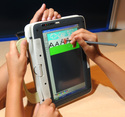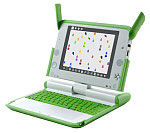Intel previews next-gen Classmate PC
Last updated Aug 20, 2008 — 6273 views Intel offered a sneak peek of the next-generation of its Classmate PC design at the Intel Developer Forum in San Francisco today. The new design features a tablet, touchscreen, and motion-sensing user interface, and is powered by — you guessed it — an Atom processor.
Intel offered a sneak peek of the next-generation of its Classmate PC design at the Intel Developer Forum in San Francisco today. The new design features a tablet, touchscreen, and motion-sensing user interface, and is powered by — you guessed it — an Atom processor.
Intel expects this new, more flexible Classmate PC design to cater to more of the needs of the worlds 1.3 billion students. “Our ethnographic research has shown us that students responded well to tablet and touch screen technology,” explains Lila Ibrahim, GM of Intel’s Emerging Markets Platform Group.
“The creativity, interactivity and user-friendliness of the new design will enhance the learning experiences for these children,” adds Ibrahim. “This is important for both emerging and mature markets where technology is increasing being seen as a key tool in encouraging learning and facilitating teaching.”







Photos of Intel’s new Classmate PC design
(Click each to enlarge; source: Intel)
Features
Key features of the prior design — introduced in June — that appear to be shared by this new version, include:
- Processor –Intel Atom N270, clocked at 1.6GHz
- Chipset — Intel 945GSE
- Memory — 256MB (Linux only) or 512 MB
- Display — 7-inch 800×480 or 8.9-inch 1024×600 color LCD
- Storage — up to 8GB NAND flash; or 30 GB HDD
- Audio — 2-channel stereo audio; built-in speakers and mic; jacks for audio in/out
- LAN/WLAN:
- 10/100Mbit Ethernet
- 802.11 b/g wireless; full MESH 802.11s support
- Keyboard/touch:
- Water-resistant integrated keyboard with hot keys cycle
- Touchpad with left/right buttons
- Camera — 30fps @ 640×480, 0.3M
- Power:
- Batteries — 4 or 6 cells, with approx. 4.5 or 6.5 hrs operation, respectively
- AC adapter for recharging batteries
- Operating system — Linux or Windows XP Pro
- Security Hardware-based theft deterrent
Key new features of the new design, according to Intel’s announcement, include:
- Touchscreen — pen and on-screen soft keyboard
- Tablet mode — simple user-interface shell; quick launcher for tablet mode
- Enhanced software — easier network connection and collaboration simple computer management, and localized, education-friendly content
According to Intel, the next-generation Classmate PC design continues many of the fundamental characteristics of previous versions of the device, such as a student-friendly, lightweight, rugged design. Also, like the earlier versions it comes with customized educational software featuring an emphasis “collaboration and 1:1 learning.”
According to Intel, changes incorporated in the new design were driven by a combination of “ethnographic research” along with the past two years of field tests. For example, because students work better in groups, the new design’s emphasis on mobility is likely to make the devices more successful than the original, tethered versions. Additionally, new options of natural input and touch are expected to make the devices more conducive to learning, particularly in math, science, art, and other subjects that involve graphing, diagramming, and drawing.
From a mechanical perspective, the new design also features a simple shell-style case that aims to allow device-makers to easily differentiate their offerings via unique color schemes and decorations. An optional soft, flexible handle serves for carrying the device and supporting it when it’s used in tablet mode.
Availability
Intel expects the new Classmate PC design to be available to device manufacturers by the end of this year. Operating system, content, software providers, and other ecosystem partners are already developing products to support the new Classmate PC version, the company adds.
Intel notes that devices based on this latest Classmate PC design will co-exist along with the earlier versions. The first-generation Classmate PC design was unveiled in May of 2006, with production commencing about a year later. In April of this year, Intel launched the second-generation design, followed by a version based on Intel’s Atom processor in June.
According to Intel the government of Portugal plans to provide 500,000 Intel-powered classmate PCs to its elementary school students, and Telmex, a leading telecom company in Mexico, is donating 50,000 of the devices to students in Mexico.
For further details, visit the Classmate PC website.
 Another low-cost laptop-style computer — aimed at students in developing nations — is available via the One Laptop Per Child project. It’s pictured at the right.
Another low-cost laptop-style computer — aimed at students in developing nations — is available via the One Laptop Per Child project. It’s pictured at the right.

“Another low-cost laptop-style computer — aimed at students in developing nations — is available via the One Laptop Per Child project.”
How ironic.
Children can do almost all the depicted scenes with paper and pencils for much less money. If they really are going to do things for which a computer is required, such as inspecting the internals of the machine and programming, using Windows is a big mistake. I hope most education authorities will understand that Windows is brain damaging as an educational tool, making children less empowered of technology than free software solutions.
While not as hilariously inept as the first Classmate, the new design still has a fan. FAIL.
I agree with Daniel.
People in my school divides in two categories:
1) Those who play games or only browse net on their computers – Windows users
2) Those who know a lot about programming, technologies – Linux or Mac users – has greater portion of mathematically/physically based people with good universal knowledge than in the 1st category..
And there are three IT teachers: Very dull female teacher using windows, moderate male teacher using windows and open-minded (and the main of them three) male teacher using Linux and Macs (not everyone knows that). Guess which teacher everyone wants to have lessons with! (with the third one, obviously)
(Personally I use 80% of time Mac, 10% of time Windows and 10% of time Linux (it was 90% Linux before Mac))
The article said that it has special shell launcher for tablet mode.
If this shell is for Windows version, it actually shows that Windows interface is honestly not so good for tablet PC. So, why still used it?
Remember that origami interface? is there someone still remember it exist?
Bottom line,kids needs special OS/user interface for them.
Specially designed from their perspective. And I don’t think Windows is.
Linux is a maybe. Sugar?
I think of some kind of “Edubuntu” Netbook Remix 🙂
Ahh..that would be perfect.
Why only up to an 8GB flash SSD? Why not have an upgrade option all the way up to 64GB? Is the form factor 1.8″? Here are some right here; http://www.google.com/products?q=64gb%201.8%22%20ssd&hl=en&sourceid=gd&rls=GGLD,GGLD:2008-12,GGLD:en&um=1&ie=UTF-8&sa=N&tab=wf
One laptop per child is really cool but these new modifications are prompting the ability and development of the brain of ayoung child by doing all the work by touching the screen with any reasoning and in a hurry to solveproblems